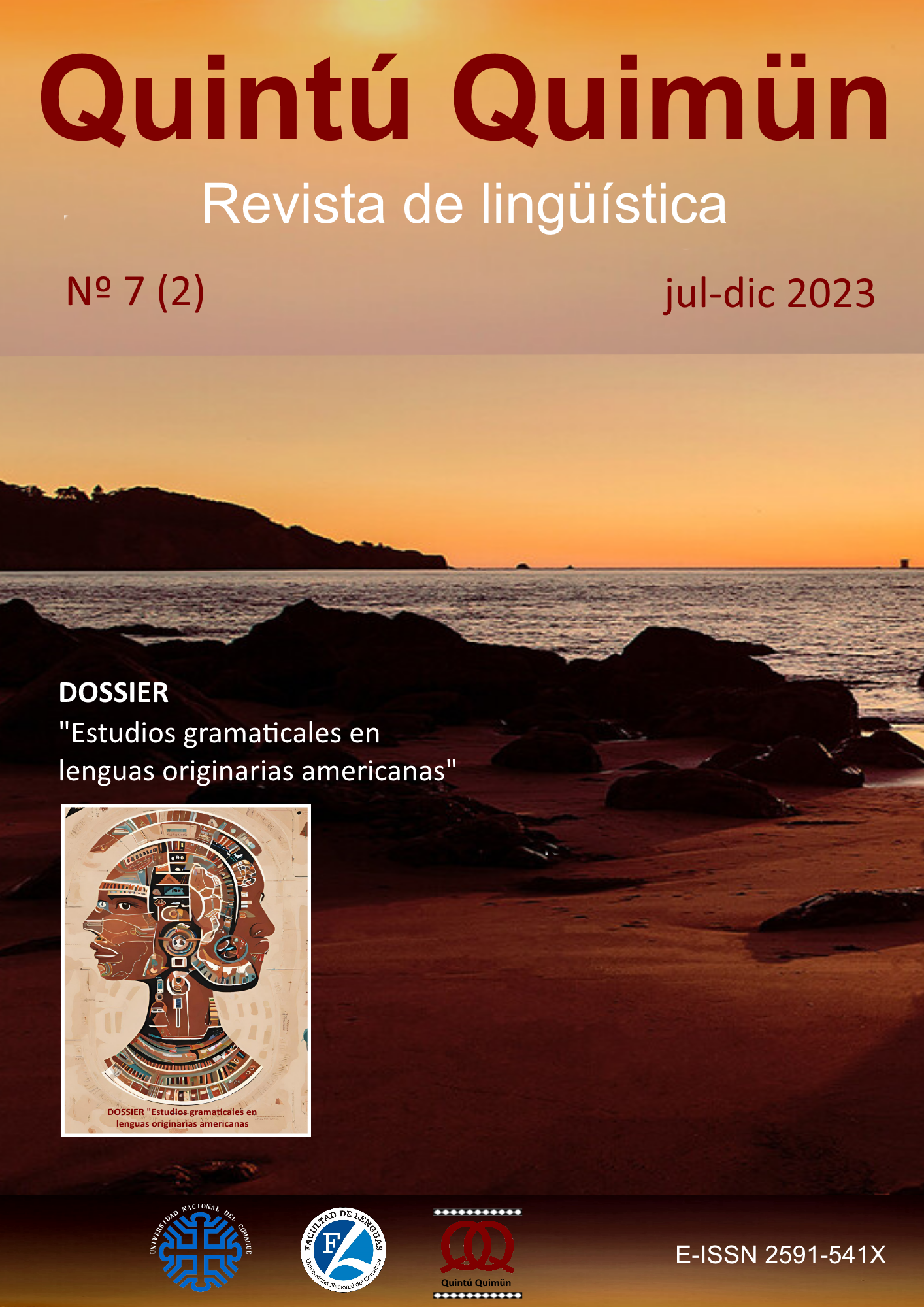The Ñembo-/Ñemo- Feigning Construction in Paraguayan Guarani
Main Article Content
Abstract
This article analyzes the Paraguayan Guarani Ñembo-/Ñemo- Feigning Construction with two aims. The first is to broaden the description of the construction, shedding light on its syntactic and semantic possibilities and restrictions. To that end, evidence of the construction is analyzed according to its behavior with aspectual classes, valency classes, the scope of negation and the -pa/-mba suffix. The second objective is to assess the hypothesis that the construction arose in the language as a result of the contact with Spanish. The analysis of earlier records of the language and of closely related languages indeed yields evidence consistent with the hypothesis.
Downloads
Article Details

This work is licensed under a Creative Commons Attribution-NonCommercial-ShareAlike 4.0 International License.
Los autores de los artículos publicados conservan los derechos de copyright.
Licencia de uso:

Creative Commons Atribución-NoComercial-CompartirIgual 4.0 Internacional.
References
Academia de la Lengua Guaraní (2020). Guarani ne’ẽtekuaa. Gramática guaraní. Tercera edición corregida. Asunción: Servilibro.
Aguilera Jiménez, Domingo (2020). Mombe’upyre, mombe’upyrã. Káso ñemombe’u. Asunción: Servilibro.
Avellana, Alicia (2014). El español en contacto con el guaraní: valores aspectuales en el dominio nominal y clausal. Revista Española de Lingüística 43/2: 7–35.
Boas, Hans C. & Steffen Höder (2018). Construction grammar and languages in contact. An introduction. En Hans Boas & Steffen Höder (eds.) Constructions in contact. Constructional perspectives on contact phenomena in Germanic languages. Amsterdam: John Benjamins, 5–36.
Califa, Martín (2022). States, changes of state, and ‘feigned states’ in Paraguayan Guarani je-/ñe- predicates. Languages 7/1: 1–22.
Carol, Javier y Alicia Avellana (2019). Tiempo, evidencialidad y miratividad en guaraní paraguayo y español de contacto: ra’e y había sido. Verba 46: 11–67.
Cerno, Leonardo (2017). Aspects of dialectal diversification of Guarani in Paraguay and Corrientes: Contact between two given languages in different settings. En Bruno Estigarribia & Justin Pinta (eds.) Guarani linguistics in the twentieth century. Leiden: Brill, 348–378.
Croft, William (2007). Construction grammar. En Dirk Geeraerts & Hubert Cuyckens (eds.) The Oxford handbook of cognitive linguistics. Oxford: Oxford University Press, 463–508.
Croft, William (2022). Morphosyntax. Constructions of the world’s languages. Cambridge: Cambridge University Press.
Estigarribia, Bruno (2017a). A grammar sketch of Paraguayan Guarani. En Bruno Estigarribia & Justin Pinta (eds.) Guarani linguistics in the twentieth century. Leiden: Brill, 7–85.
Estigarribia, Bruno (2017b). Insertion and backflagging as mixing strategies underlying Guarani-Spanish mixed words. En Bruno Estigarribia & Justin Pinta (eds.) Guarani linguistics in the twentieth century. Leiden: Brill, 317–347.
Estigarribia, Bruno (2020). A grammar of Paraguayan Guarani. London: UCL Press.
Goldberg, Adele (1995). Constructions. A construction grammar approach to argument structure. Chicago: Chicago University Press.
Goldberg, Adele (2006). Constructions at work. The nature of generalization in language. Oxford: Oxford University Press.
González, Hebe (2005). A grammar of Tapiete (Tupi-Guarani). Tesis de doctorado, University of Pittsburgh.
Gregores, Emma & Jorge Suárez (1967). A description of colloquial Guarani. La Haya/París: Mouton & Co.
Guasch, Antonio (1996). El idioma guaraní. Asunción: CEPAG.
Gynan, Shaw (2017). Morphological glossing conventions for the representation of Paraguayan Guaraní. En Bruno Estigarribia & Justin Pinta (eds.) Guarani linguistics in the twentieth century. Leiden: Brill, 86–130.
Haspelmath, Martin (2022). Valency and voice constructions. Manuscrito no publicado. Recuperado a partir de https://ling.auf.net/lingbuzz/005941 el 7 de septiembre de 2023.
Horn, Lawrence (1989). A natural history of negation. Chicago: University of Chicago Press.
Krivoshein de Canese, Natalia & Feliciano Acosta Alcaraz (2007). Gramática guaraní. Asunción: Servilibro.
Pinta, Justin & Jennifer L. Smith (2017). Spanish loans and evidence for stratification in the Guarani lexicon. En Bruno Estigarribia & Justin Pinta (eds.) Guarani linguistics in the twentieth century. Leiden: Brill, 285–314.
Ruiz de Montoya, Antonio. (2011 [1639]). Tesoro de la lengua guaraní. Asunción: Centro de Estudios Paraguayos “Antonio Guasch”.
Smith, Carlota (1997). The parameter of aspect. Dordrecht: Kluwer.
Tonhauser, Judith (2006). The temporal semantics of noun phrases: Evidence from Guaraní. Tesis de doctorado, Stanford University.
Van Valin, Robert Jr. (2005). Exploring the syntax-semantics interface. Cambridge: Cambridge University Press.
Van Valin, Robert Jr. & Randy LaPolla (1997). Syntax. Structure, meaning, and function. Cambridge: Cambridge University Press.
Velázquez-Castillo, Maura (1996). The grammar of possession. Inalienability, incorporation, and possessor ascension in Guaraní. Amsterdam: John Benjamins.
Velázquez-Castillo, Maura (2002). Guarani causative constructions. En Masayoshi Shibatani (ed.) The grammar of causation and interpersonal manipulation. Amsterdam: John Benjamins, 507–534.
Velázquez-Castillo, Maura (2005). Aspecto verbal en el español paraguayo: elementos del sustrato. En Margaret Lubbers Quesada & Ricardo Maldonado (eds.) Dimensiones del aspecto en español. México: Universidad Nacional Autónoma de México, 149–172.
